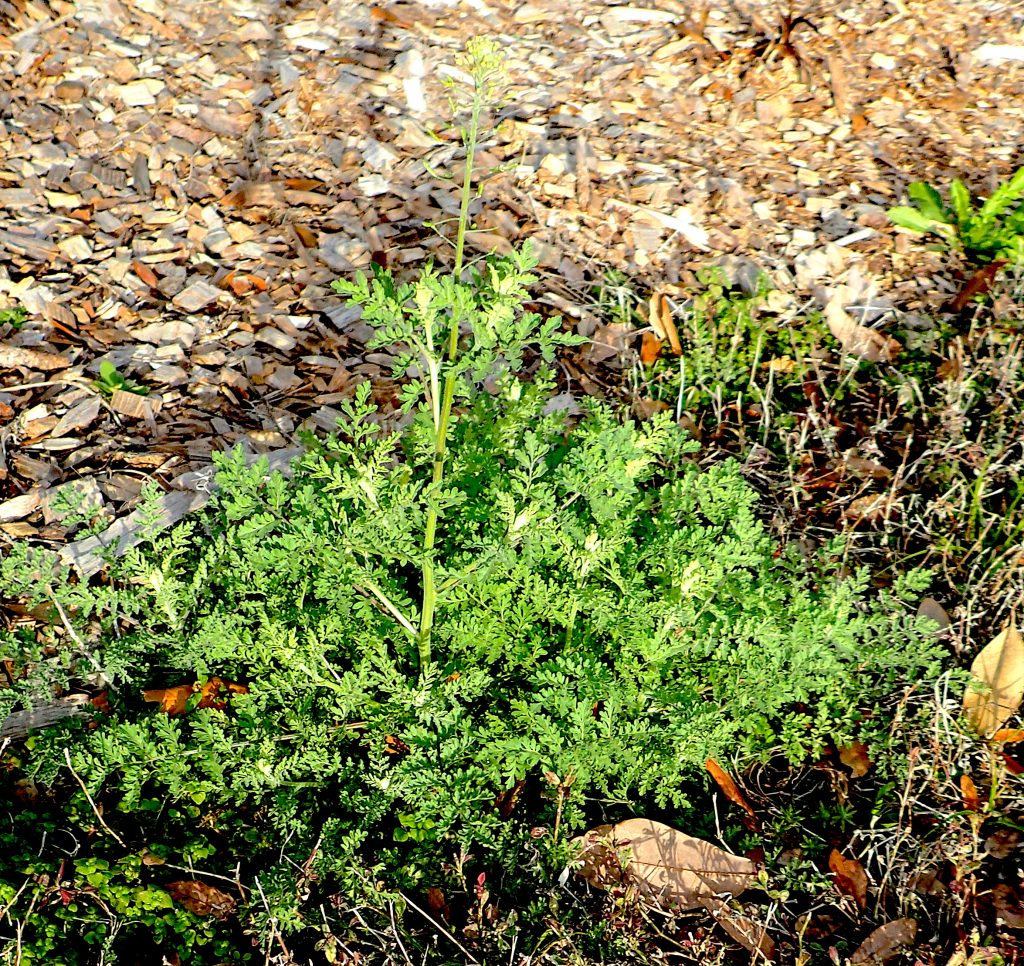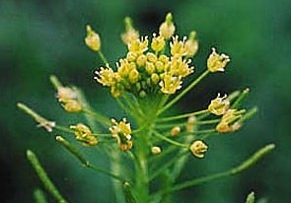
Western Tansy Mustard. Photo by Green Deane
Descurainia pinnata: Abandoned Seed
What shall we call this little member of the Brassica family? Western Tansy Mustard or Tansy Mustard? We could always opt for its scientific name: Descurainia pinnata (des-kur-AY-nee-ah pin-AY-tah.)
I am hesitant to call it the Western Tansy Mustard because it definitely grows here in eastern Central Florida, that’s hardly west unless you’re living in Europe. It’s our native tansy mustard vs. a European import (which is why it’s called “western.”)
It shares many of the characteristics of a subset of members of that popular family: Small edible leaves, spicy seeds in pods, rangy growth, the ability to survive in dry areas, and four-petaled yellow flowers resembling a cross.

Blossoms of western tansy mustard
Other writers say older leaves of tansy mustard are edible cooked but bitter. They say as young spring greens can be salty. I have found them to be neither bitter nor salty and edible raw as well as cooked though the raw texture is a bit cottony. The seed pods are an interesting nibble and can be pickled but they are tiny. The seeds are edible raw or cooked and have been used as piñole. The seeds can also be used to flavor soups, as a condiment ground into a powder mixed with cornmeal, used to make bread or to thicken soups and stews. In Mexico the seeds are made into a drink with lime juice, claret and sweet syrup. That’s a lot for such a minute seed. Medically natives ground up the seeds and used them in the treatment of stomach complaints. A poultice of the entire plant was used to ease the pain of toothache. An infusion of the leaves was used as a wash on sores.
The D. pinnata grows from Quebec to British Columbia, Florida to California, and south into Mexico including Chihuahua, Sinaloa, and Sonora. It was more used by Western Indian tribes than eastern because the eastern diet was supplanted by beans, maize and squash.
The Tansy Mustard was a major plant for various Indian communities. The Hohokam cultivated the plant, the Maricopa and Quechan baked the young greens in pits. They would alternate layers of greens and hot rocks then cover the top with earth. Of prime use, however, were the seeds, They were eaten by the Atsugewi, Cahuilla, Cocopa, Gosiute, Hopi, Kawaiisu, Keres, Maricopa, Mojave, Navajo, Paiute, Papago, Pima, and Quechan. Up to a century ago the seeds were still sold in large quantities near Indian villages. That’s rather amazing since the seed is about the size of the eye of a needle.
Typical preparation of the seeds was to collect them when ripe. The plants heads were shaken into baskets to collect the microscopic seeds. They were then mixed with water and eaten like a mush (they are a bit mucilagenous, perhaps why they settle tummies.) Another way was to grind them and mix with cold water and sugar, much as the modern drink is still made.
Interestingly the Pima also used the seeds to remove foreign objects from the eye. They would put one seed in the eye and it would bring out the offending debris, so they say. I’m not sure putting a mustard seed in the eye is a good idea. They can be spicy. Another non-culinary use was the Hopi mixed the ground seed with iron to make a pigment for pottery.
The Descurainia genus honors Francois Descurain, 1658-1740, a French botanist and pharmacist. “Pinnata” is from the Latin word for “feather”, describing the finely cut leaves. “Tansy” comes from the Greek word “Athanasia” meaning “immortal” in that its blooms last a long time. “Mustard” comes from the Latin word “mustum” which means “young wine” read tart, rank and or bitter.
Lastly, the Tansy Mustard is toxic to livestock in more than small quantities, especially if there is a lot of selenium in the soil. It is difficult for humans, who are not grazers, to eat that much. Grazing cattle can go blind and die from it.
Green Deane’s “Itemized” Plant Profile
IDENTIFICATION: An annual cool-season forb to 2.5 feet high, usually single-stemmed, leafy, covered with fine, gray hairs. Leaves alternately along wavy stems, each divided into small segments. Flowers range from yellow to whitish, in long clusters at stem ends, four petals but oddly shaped. Very distinctive club-shaped fruit, long, round, slender, two-celled capsules filled with many small, waxy seeds. It’s a silique meaning it separates like a V-sign with your fingers but in between is a small tongue holding all the seeds.
TIME OF YEAR: Flowers January to July depending upon climate, seeds pods follow quickly.
ENVIRONMENT: Plains, hills, disturbed areas, does very well in sandy soil and the desert.
METHOD OF PREPARATION: Young leaves as greens or older leaves cooked. Young leaves and seeds pods as a trail side nibble or for seasoning or pickling. Seeds have many uses including drinks, breads, mush, thickener and flavoring. It picks up selenium from the soil.


I like the “Itemized Plant Profile” as it is making it easier for me to apply the description to what I’m now growing in a limited area – a pot three feet in diameter. Indeed the seeds are extremely minute . In fact I’ve gone through the above information in order to make a suitable comment on “Tansy Mustard” I’m now reading about in EatTheWeeds issue of 21 Jan 2014.
More money coming as I can afford to give. I find myself returning to your site again and again as a definitive source. One small suggestion/request that I would make would be a thumbnail index guide to all the plants that you’ve described. It would be invaluable for identification purposes.
Once again, a million thanks. I am now yanking and killing all the dog fennel so that it doesn’t cross-pollinate with my fennel, dill, and coriander. You da man!
I notice this is the same picture as in another very informative article you wrote about edible flowers.
This was the same picture as for common tansy.
Are they so close that one picture can be used to ID the other ?
I too this photograph last week. So it cannot be in my flower articles because I wrote them long before last week. It might be in a recent newsletter. Please, what other article are you referring to?
I am afraid I see a picture of tansy flowers. Not any mustard at all.
I took that photo. It is definitely of a Western Tansy Mustard.